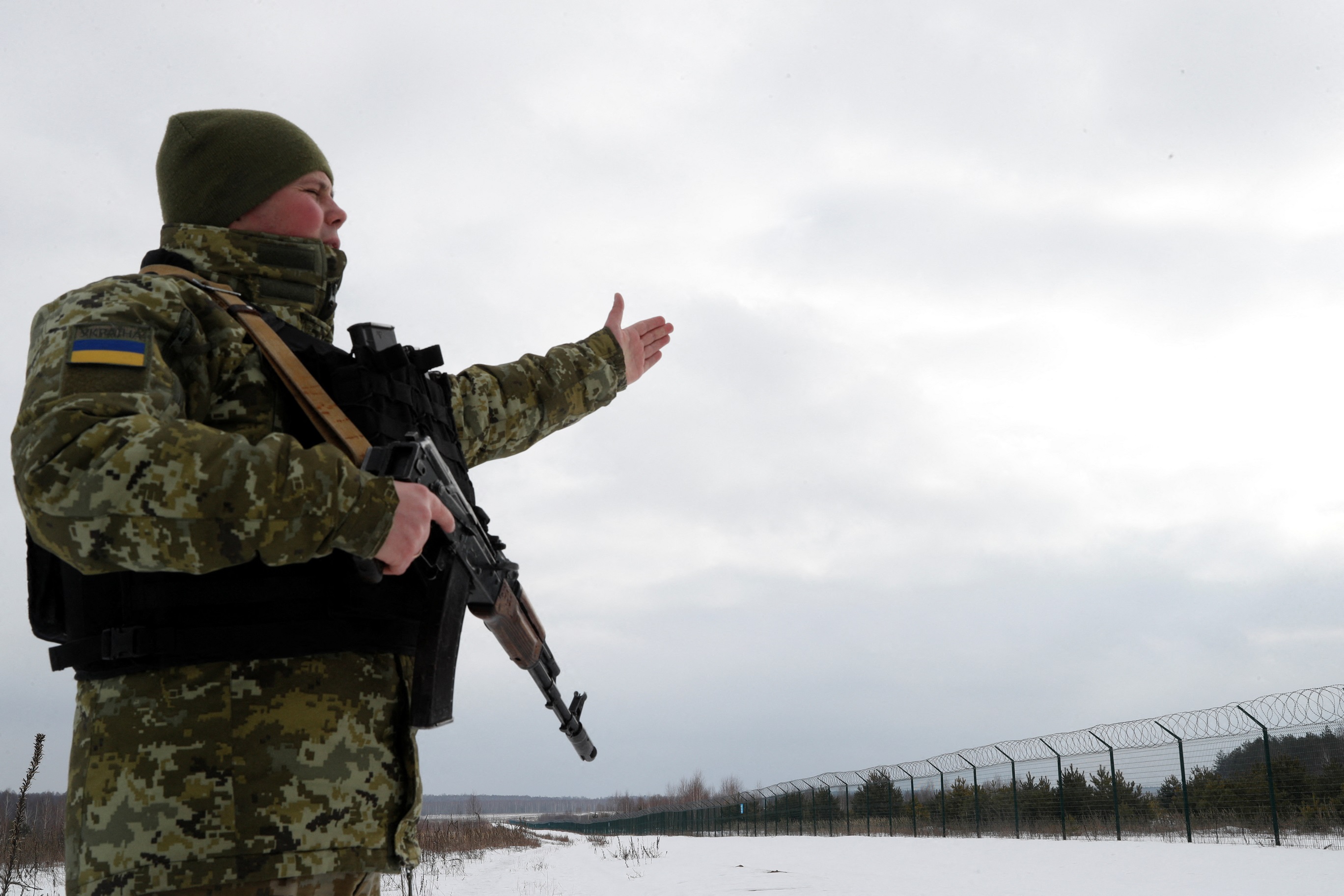West warns Russia is moving troops towards, not away from, Ukraine
Sign up now: Get ST's newsletters delivered to your inbox

A member of the Ukrainian State Border Guard Service patrols the area near the frontier with Russia in the Chernihiv region of Ukraine, on Feb 16, 2022.
PHOTO: REUTERS
Follow topic:
MOSCOW/KYIV (REUTERS) – Russia’s military build-up near the Ukrainian border is continuing, the United States warned on Wednesday (Feb 16) as Estonia said battle groups were approaching ahead of a likely attack to occupy “key terrain”, despite Moscow’s insistence of a pullback.
There have been sightings of additional armoured vehicles, helicopters and a field hospital moving towards Ukraine’s borders, Britain’s defence intelligence chief Jim Hockenhull said in a rare public statement.
World powers are engaged in one of the deepest crises in East-West relations for decades, jostling over post-Cold War influence and energy supplies as Russia wants to stop Ukraine ever joining the Nato military alliance.
Western nations have suggested arms control and confidence-building steps to defuse the standoff, which has prompted them to urge their citizens to leave Ukraine because an attack could come at any time.
Russia denies it has any plans to invade.
“There’s what Russia says. And then there’s what Russia does. And we haven’t seen any pullback of its forces,” US Secretary of State Antony Blinken said in an interview on MSNBC.
“We continue to see critical units moving toward the border, not away from the border.”
Estonian intelligence is aware of around 10 battle groups of troops moving towards the Ukrainian border, where it estimates about 170,000 soldiers are already deployed, said Mikk Marran, director-general of the Estonian Foreign Intelligence Service.
The attack would include missile bombardment and the occupation of “key terrain”, he added.
“If Russia is successful in Ukraine, it would encourage it to increase pressure on the Baltics in the coming years,” he said. “The threat of war has become main policy tool for Putin.”
Russia’s defence ministry said its forces were pulling back after exercises in southern and western military districts near Ukraine. It published video that it said showed tanks, infantry fighting vehicles, and self-propelled artillery units leaving the Crimean peninsula, which Moscow seized from Ukraine in 2014.
But Nato military commanders are drawing up plans for new combat units that diplomats said could be deployed in Bulgaria, Romania, Hungary and Slovakia.
Such units – designed to buy time for additional troops to reach the front line if needed – already exist in Poland and the Baltic states.
Britain will double the size of its force in Estonia and send tanks and armoured fighting vehicles to the small Baltic republic bordering Russia as part of the Nato deployment.
‘Day of unity’
Ukraine also increased the number of border guards on its frontier with Belarus, Russia’s ally, where some 9,000 Russian troops are estimated to be involved in military exercises.
President Volodymyr Zelenskiy, who is criss-crossing the country to help bolster Ukrainians’ morale, observed drills by his armed forces that included Javelin anti-tank missiles.
Wednesday is a patriotic holiday in response to the reports Russia could invade on that day. “No one can love our home as we can. And only we, together, can protect our home,” he said.
People raised flags and played the national anthem to show unity against fears of an invasion.
The government said a cyber attack that hit the defence ministry was the worst of its kind the country had seen, pointing the finger at Russia, which denied involvement.
US officials were as yet unable to say who was responsible, White House spokesperson Jen Psaki said.
She reiterated US claims that a Russian attack could be preceded by a ‘false flag’ operation and misinformation.
The risk of Russian aggression against Ukraine would remain high for the rest of February and Russia could still attack Ukraine “with essentially no, or little-to-no, warning”, according to a senior Western intelligence official.
Nato said it could prove Russia’s failure to pull back its troops with satellite imagery. “More troops are on their way,” said Secretary-General Jens Stoltenberg.
Moscow’s ambassador to Ireland insisted forces in western Russia would be back to their normal positions within three to four weeks.
Russia sees Ukraine joining Nato as a threat to its security and that it is ready to reroute energy exports to other markets if it were hit by sanctions, which Washington and its allies have threatened if it invades.
Finance Minister Anton Siluanov said sanctions against Russian banks would be “unpleasant” but the state would ensure all bank deposits and transactions were secured.
Moscow has accused Washington of hysterical war propaganda after repeated warnings of a possible attack and reports in some Western media that it would happen on Wednesday as the world powers snipe at each other.
The State Department on Wednesday said it was concerned by Putin saying “genocide” was taking place in eastern Ukraine’s Donbass region, where conflict between government forces and Moscow-backed separatists has cost 15,000 lives.
Spokesman Ned Price also said it was “entirely false” that Washington and Kyiv are developing biological or chemical weapons for use in the region.
Despite the war of words, diplomatic efforts continue.
President Joe Biden and German Chancellor Olaf Scholz underscored the “importance of continued transatlantic coordination” on a call on Wednesday, the White House said.
Ukraine has asked the UN Security Council to discuss a bid by Russia’s parliament to recognise self-proclaimed separatists in eastern Ukraine when the body meets on Thursday.
Blinken will travel to Germany for the Munich Security Conference, which starts on Friday, to coordinate with allies.
“The door continues to be open to diplomacy,” said Psaki.

